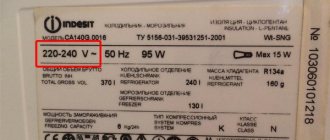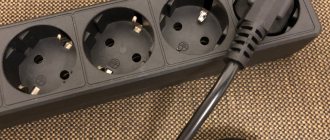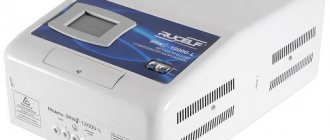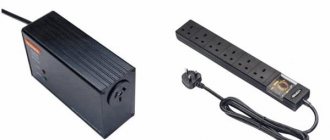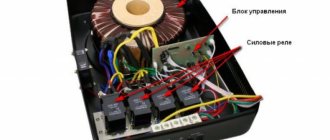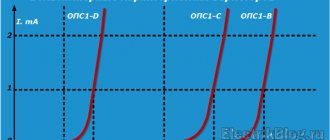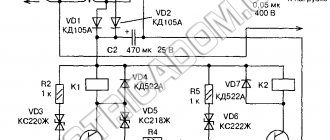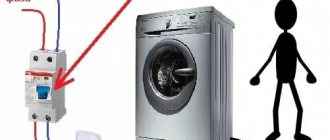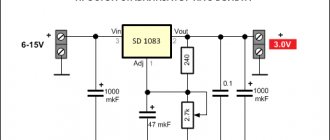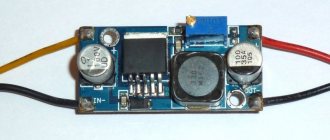Here we will talk about voltage stabilizers for apartments. If you live in a private house (in a cottage, in a country house), then you better read this article, since the electrical network in a countryside area still has its own specifics.
Before you start choosing a specific model, it would be nice to ask yourself the question: is a voltage stabilizer needed in the apartment? Maybe a surge protector or a voltage relay is enough?
So do you need a stabilizer or not?
To answer this question, it is enough to measure the voltage in the outlet at different times of the day. Especially in the evening, when most of the residents of your home come from work and turn on their kettles, microwaves and welding inverters.
In accordance with the requirements of the International Electrotechnical Commission IEC 60038:2009 (GOST 29322-2014), the household voltage must be in the range of 230V±10%. But since at the moment in many regions outdated standards (220V ± 10%) are still in effect, the range of 198...253 Volts is actually “allowed”.
To obtain a reliable picture, it is necessary to measure voltage over a long period of time. Measurements must be taken in all parts of the day - morning, afternoon, evening and night. If possible, it is better to invite a specialist from a company conducting energy audits. He will install special equipment that will collect and analyze information within a day.
In the vast majority of cases, the voltage in the apartment is within acceptable limits and does not need stabilization.
However, if the observation results show long periods when the voltage exceeds 253V or is below 198V, then the problem really exists. But you should not immediately go to the store for a stabilizer.
Firstly, it makes sense to write a complaint to your local energy supply organization, citing voltage non-compliance with standards (GOST 29322-2014).
Secondly, your particular household appliance may not be at all critical to the value of the supply voltage.
Household appliances that don't care
An approximate list of equipment that can easily withstand serious mains voltage fluctuations is presented below.
- Modern refrigerators. You can find out why this is so here.
- Modern TVs. We talked about this in detail in this article.
- Computers and monitors. Having your own voltage converter (switching power supply) minimizes the influence of mains voltage on their performance. More details here.
- Active load: irons, tongs and hair dryers, heaters, instantaneous water heaters, electric stoves, shoe dryers, etc. It will work in any case, although the amount of heat generated is a quadratic function of the voltage.
- Sound-reproducing equipment: stereo systems, home theaters, amplifiers, electric bells, etc. Audiophiles will, of course, disagree with me. There is even a separate article on this topic.
- LED bulbs. Thanks to the current driver built into the lamp, the brightness of the light does not depend on the supply voltage.
Devices sensitive to supply voltage
And these household appliances react poorly to voltage fluctuations in the network. In advanced cases, failure is possible.
- Air conditioners and vacuum cleaners. These devices contain asynchronous motors, which, when the voltage is reduced*, begin to consume more current than required, which is why the motor windings become very hot. In such cases, all hope lies with the thermal relay. If it does not de-energize the circuit, then due to severe overheating, a breakdown is possible. And if the engine does start, it will not work at full power.
- Old refrigerators. They have exactly the same drawback as air conditioners. When the mains voltage is low, the engine hums and overheats.
- Ancient TVs. Changes in mains voltage change the raster size and image brightness. But there are almost no such TVs left now.
- Fluorescent and energy-saving lamps. If the voltage is low, they may not light up.
- Incandescent lamps. The brightness of the glow very much depends on the voltage in the network: a decrease in voltage of just 10% leads to a 25% decrease in brightness, and at 180 volts a 60-watt light bulb turns into a 25-watt light bulb.
- Microwave ovens. When the supply voltage decreases, the power of the microwave radiation drops so much that the microwave becomes virtually impossible to use.
- Washing machines. When the voltage drops below a critical level, the controller stops the washing program and displays the corresponding error on the indicator. In old washing machines “without brains” the motor may burn out.
- Dishwashers. If the voltage in the outlet is “wrong,” it simply won’t turn on.
- Sophisticated boilers. Boilers packed with electronics simply turn off when the voltage goes beyond acceptable limits.
*"reduced voltage" means a voltage of 180V or lower.
ELITECH ASN 2000РН – effective protection of household appliances
Highly efficient voltage stabilizer. Reaction speed reduced to 0.005 seconds - instant results.
The power of the device allows you to simultaneously connect a TV, refrigerator, microwave or electric oven, multicooker or other combinations of household appliances. The range of input parameters of the electrical network has been expanded to 100~260 volts.
A forced cooling system has been built in, so the equipment can now operate on hot summer days without overheating.
Pros:
- Quality, effectively protects against voltage surges.
- Quiet operation, good forced cooling.
- Small dimensions, possibility of wall mounting.
Minuses:
- Not tagged by users.
Stabilizer selection
If a stabilizer is still needed, then before going to the store you should at least study the hardware a little. You shouldn’t rely on sugary sellers who, in fact, don’t care how it will work later. It will be much safer to figure everything out yourself and make an informed choice. Below is all the necessary information on how to choose a voltage stabilizer for an apartment.
So, the selection of a specific model of apartment voltage stabilizer can be divided into three stages - choosing the type of device and the number of phases, as well as finding the minimum required power. Let's look at these stages in more detail.
Stabilizer type
Modern stabilizers come in 4 types*:
- Relay. The cheapest devices have step adjustment. There is only one obvious drawback - it clicks during operation (for more details, see here).
- Electromechanical (also servo-driven or “later”). They work on the LATR principle, have smooth adjustment, but the lowest response speed. They require tech. maintenance once a year and a half.
- Electronic (also known as triac or thyristor). Silent and fast, but expensive and not very reliable. Output voltage adjustment is stepwise.
- Double conversion. The most expensive, but with maximum accuracy of stabilization and filtering from input interference. Suitable for laboratory and medical equipment. Use in everyday life is inappropriate.
*Previously, in Soviet times, there were also ferroresonant stabilizers, but we won’t even consider such exotic ones. Their time is irrevocably passed.
Electromechanical stabilizers are good for everyone: inexpensive, the light does not blink during switching, reliable and as simple as three kopecks. But I still wouldn’t recommend them, because... they require periodic maintenance (replacement of current-collecting brushes), which means additional time and financial costs. In electrodynamic stabilizers, the problem of wear of graphite brushes is solved by replacing them with a wear-resistant roller, but the price of devices of this type has increased significantly.
In double conversion stabilizers, the output voltage is generated by the stabilizer circuit. Thanks to this circuit design, maximum stabilization accuracy is ensured - 1% and even higher. Network interference also has no chance of leaking to the protected load. Excellent stabilizers, but the price... Buying one for your home is like shooting sparrows from a cannon.
Electronic stabilizers , in principle, are suitable for home use. Fast, silent, do not require any surgical intervention. But, in my opinion, they are still a little expensive. I think it’s better to wait until powerful triacs become significantly cheaper.
Based on my work experience, I can say that the most suitable option for apartment equipment is a relay type stabilizer . High-quality relays provide a good mean time between failures and a very high switching speed (about 20 ms), which is no worse than that of electronic stabilizers. An undoubted advantage of relay-based stabilizers is the complete absence of any input sine distortion, which is greatly appreciated by audiophiles and other aesthetes.
At the same time, the circuit design of relay stabilizers is simpler than that of electronic ones, since additional protection and heat removal circuits for delicate thyristors/triacs are eliminated. Ultimately, this has a positive effect on the reliability of the device as a whole and its price.
In order not to be unfounded, I give the comparative cost of one kilowatt of output (stabilized) voltage for stabilizers of different types:
| Stabilizer type | Cost per kilowatt |
| Relay | from 850 rub. |
| Electromechanical | from 1050 rub. |
| Electronic | from 3000 rub |
| Double conversion | from 5000 rub |
Considering the above, the conclusion is obvious - the ideal option for an apartment is a relay stabilizer .
Number of phases
We have decided on the principle of operation, now we need to decide how many phases a 220V voltage stabilizer for an apartment should have.
In general, everything is simple here: household appliances definitely need a single-phase stabilizer . There are simply no three-phase consumers in normal apartments.
In truth, in non-gas homes you can sometimes see a large, powerful 4-burner stove designed for a 3-phase connection. A separate input cable is made for it into the apartment and a special non-standard socket is installed in the kitchen. But, of course, there is no point in feeding such an electric stove with a stabilized voltage.
How much power do you need?
So, now the most important question: what power should I buy a stabilizer for my apartment?
In general, everything here is very individual and depends on your household appliances, their power and quantity. If you would like to install a stabilizer only for lighting, then some 500-600 W will be enough. And if there is a need to power the entire apartment through a stabilizer, then you will need a device with a power of 10-15 or even 20 kW.
In order not to overpay for extra kilowatts, you will have to work a little and make some calculations.
The algorithm for calculating the power of a voltage stabilizer in an apartment is as follows:
- It is necessary to sum up the rated power of all devices in the apartment. The exact power values can be taken from the device data sheet or searched on the case. Approximate power values are given in Table 1 (see below).
- Determine the device that has the greatest starting power (most likely it will be an air conditioner or an electric meat grinder). Calculate the difference between peak and rated power for this appliance. Add the resulting difference to the value obtained in step 1.
- The value obtained in the previous paragraph must be multiplied by 1.2.
Table 1. Approximate power consumption values for modern household appliances.
| Consumer type | Rated power, W | Starting power, W |
| Electric drill | 800 | 950 |
| Angle grinder (“grinder”) | 2200 | 2800 |
| Hammer | 1300 | 1600 |
| Belt grinder (grinder) | 1000 | 1200 |
| Vacuum cleaner | 1400 | 1700 |
| Fridge | 600 | 2000 |
| Ice cream making machine (freezer) | 1000 | 3500 |
| Boiler, boiler | 500 | 1700 |
| Air conditioner | 1000 | 3500 |
| Washing machine | 1000 | 3500 |
| Radiator | 1000 | 1200 |
| Lighting | 500 | 500 |
| Electric stove | 6000 | 6000 |
| Electric furnace | 1500 | 1500 |
| Microwave | 800 | 1600 |
| TV and audio equipment | 500 | 500 |
| Electric meat grinder | 1000 | up to 7000 |
If there are mutually exclusive devices that will never turn on at the same time, then when calculating the total power consumption, only one of them needs to be taken into account - the one with more power.
Thus, to calculate the stabilizer power required for any apartment, you need to take only three steps.
Example of power calculation
As an example, I give calculations of the stabilizer power for my own apartment.
- I calculate the total rated power of all electrical appliances:
Consumer type Rated power, W Starting power, W All light bulbs 400 400 TV Sony KDL-48W705C 92 92 Desktop computer 200 200 Apple MacBook Pro 13 MGX72 65 65 Vacuum cleaner 1800 2180 Grinder Bosch GWS 13-125 1300 1690 Rotary hammer Bosch GBH 2-28 880 1090 Refrigerator Wirlpool ARC4020 200 1000 Washing machine LG F1096TD 2100 3500 Heater 1500 1800 Microwave 800 1600 Iron 2200 2600 So, the total rated power of everything electrical in my apartment is 10657 W.
As you can see, the hammer drill was excluded from the calculations, since I am absolutely sure that the angle grinder and the hammer drill will never work together. So, of these two tools, only the grinder was left (as having the greatest power).
- Now we need to find the device that has the highest starting power. In my case it's a washing machine. The difference between rated and starting power is:
3500 - 2100 = 1400 WThus, the maximum power consumption of all household appliances is:
10657 + 1400 = 12057 W
- It remains to find the required stabilizer power, taking into account a 20% margin:
12057 · 1.2 = 14468 W (rounded to 15 kW)
As you can see, even my small apartment needs at least a 15-kilowatt voltage stabilizer. Therefore, people who know how to count money connect through the stabilizer only that equipment for which the supply voltage is truly critical.
Attention! Manufacturers of stabilizers, who have something to hide, instead of active power (Watts, W) try to indicate reactive power (Volt Amperes, VA) in the most visible place. Keep in mind that reactive power is always higher—sometimes three times higher. Therefore, always check exactly the active component of the power that the model you are interested in provides for a long time.
Why do fluctuations occur in electrical networks?
It's all about the distance to the source that supplies us with electricity. In a city, as a rule, this is an electrical substation where the necessary voltage adjustment is made depending on the situation at a given time in a particular area.
There is one more important point, but it is more relevant for country houses. When the distance to the substation is large enough, the voltage in your house will always be low, and if you live close to a distribution substation, the voltage will be high.
This happens because due to voltage losses in power lines, it is impossible to make it the same in all areas and for all consumers.
The voltage value of 220 volts is set at an area mid-distance from the substation. The voltage there will always be normal. And in other areas it is necessary to use stabilizers that equalize the voltage to the required and stable value.
Ready solutions
I am often asked to recommend some good voltage stabilizer for an apartment, so I provide a list of reliable and time-tested models that are 90% likely to suit you.
All stabilizers are relay type, except the last one (it is electromechanical with brushes).
| Model | Power | Input range | Accuracy | Execution | Price |
| RESANTA LUX ASN-10000N/1-C | 10 kW | 140…260 V | 8% | Wall | 7500 rub. |
| RESANTA LUX ASN-10000/1-C | 10 kW | 140…260 V | 8% | Floor | 8500 rub. |
| RUCELF SRWII-12000-L | 10 kW | 110…270 V | 8% | Wall | 15100 rub. |
| REAL-EL WM-10/130-320V | 10 kW | 130…320 V | 8% | Wall | 15400 rub. |
| ENERGY ASN-15000 | 12 kW | 120…280 V | 6% | Floor | 26400 rub. |
| SUNTEK SNET 16000 | 16 kW | 120…285 V | 5% | Universal | 18500 rub. |
| SUNTEK SNET 15000-EM | 15 kW | 140…270 V | 2% | Floor | RUB 28,000 |
All of the listed stabilizers have the “BYPASS” function - this is when the input is connected to the output directly, the stabilizer, in fact, is completely excluded from the electrical circuit. A very convenient thing if you do not need constant voltage stabilization. Or you would like to temporarily connect a very powerful load that your stabilizer is guaranteed not to pull (for example, a welding machine).
RESANTA ACH-10000/1-C
RESANTA ACH-10000/1-C is an inexpensive single-phase relay stabilizer for 10,000 W. It is a small metal box with handles for carrying (handles are very useful, since it weighs about 20 kg).
It responds very quickly to changes in network voltage (reaction speed is only 7 ms). A reliable model, I have been watching two copies for the third year now and have no complaints. All information is displayed on the digital display on the front panel. The only thing that is depressing is the loud clicks when switching windings. Therefore, it is not recommended to place it at the head of the bed in the bedroom. And the backlight of the screen is very bright, it will illuminate the bedroom.
There is exactly the same model, only in a mounted version (RESANTA ACH-10000Н/1-Ц), all the characteristics are the same, but it costs almost a thousand less. The photo below shows both modifications at once.
Both models have a built-in surge filter to protect against high-frequency and impulse noise. There is protection against short circuit in the load, as well as against excess power and overheating.
By the way, cooling is done using a fan mounted inside, which turns on under load. Like any other power devices, it is not recommended to keep these devices under 100% load for a long time, so when choosing a stabilizer, be sure to provide some power reserve (20-30 percent).
RUCELF SRWII-12000-L
RUCELF SRWII-12000-L - this household voltage stabilizer has proven itself well due to its long-term uninterrupted operation. During my practice, I have never heard of this model breaking.
Unlike previous models, it has a durable body and a nice design, so it fits well into any apartment.
The LCD screen installed on the front of the device displays not only the input and output voltage, but also the power load scale. Conveniently control network parameters.
Many people prefer wall mounting of stabilizers, because... At the same time, it does not take up extra space in the apartment, you can put all the wiring in cable channels, children cannot reach buttons and other controls. The fastening of this device must be reliable, because this box weighs almost 25 kg. In general, a large mass of a relay stabilizer is a sign of high power.
REAL-EL WM-10/130-320V
REAL-EL WM-10/130-320V is a Ukrainian-made wall stabilizer designed for serious fluctuations in the electrical network. In my opinion, it is an underrated model, and this should be used. True, it is now difficult to find on sale.
It has forced cooling, which turns on as needed (by default the fan is silent). Easily copes with increased voltage (up to 320 Volts). It clicks a bit when stabilizing, so it's best to install in a hallway.
It has built-in protection against overload, overvoltage, overheating and impulse noise. An excellent stabilizer for household appliances.
Perhaps the black color of the case will be an additional advantage for some. There are not many stabilizers in non-standard colors on the market.
ENERGY ASN-15000
ENERGY ASN-15000 is a floor-standing single-phase relay stabilizer with a wide range of input voltages. For the last few years it has been produced at the Russian plant ETK Energia.
It has several levels of protection: automatic overload protection, protection against overheating (120°C), overvoltage protection (280V), and too low voltage protection (120V). There are built-in voltmeters and ammeters.
Does not distort the shape of the output voltage. Has 5 levels of adjustment. A little noisy when switching.
The input and output are made in the form of terminals, which hints at a stationary placement. Yes, you can’t drag it around much - the weight of the device is about 19 kg.
Requires reliable grounding. Of course, it will work without a grounding conductor, but then it is necessary to ensure that the stabilizer is absolutely inaccessible from touch (which is hardly achievable in practice).
SUNTEK SNET 16000
SUNTEK SNET 16000 is a powerful relay voltage stabilizer for household appliances. Capable of operating at full power already from 140V at the input. Within a few seconds it can withstand a 50% overload, which is very important when working for a consumer with high starting currents (vacuum cleaner, air conditioner, refrigerator).
It has a higher stabilization accuracy compared to the above models - about 5%. The built-in control system itself switches the cooling method from natural circulation to forced airflow.
With a 25% reduction in power, it is capable of operating at 120 Volts. A further decrease in the input voltage de-energizes the load to protect it from failure. Like all relay stabilizers, it does not affect the sinusoidality of the output voltage at all.
Placement is possible both on the floor and mounted (wall). Has terminal blocks at the input and output. It can easily withstand strong voltage surges from a nearby welding inverter. It has varistor protection against high-voltage pulses (for example, a nearby lightning strike).
It is designed for round-the-clock uninterrupted operation and has demonstrated excellent reliability.
SUNTEK SNET 15000-EM
SUNTEK SNET 15000-EM is a floor-mounted single-phase electromechanical stabilizer. It has high efficiency (more than 97%), reduced noise level and increased overload capacity.
Here the main advantage of all electromechanical stabilizers is fully realized - smooth adjustment. So you can forget about the abrupt change in the brightness of the lamps, which is inevitable when using stabilizers with step adjustment (relay, thyristor).
The second advantage over relay ones is the high stabilization accuracy, which in this model reaches 2%.
The operating range of the stabilizer is from 140 to 270 Volts. When operating at partial power, the operating range expands to 120-285V.
The box is equipped with rollers to roll it from place to place. Not everyone can lift it (after all, 54 kg of live weight!).
An excellent model of a 220 Volt household voltage stabilizer! I would recommend it to everyone if it were not for the relatively high cost and the need for periodic maintenance. But if this doesn’t bother you, then take it and use it. You will not regret.
Powerman AVS 500 C 6090625 – small and remote
Compact transformer voltage stabilizer. Conveniently placed on a table or hung on a vertical surface.
The main function is to stabilize the output parameters of the electric current. Additional, like a surge protector. Equipped with sockets for connecting two consumers, for example, a computer and a TV. The case is made in a modern space design.
Pros:
- Stylish, compact, lightweight. Takes up little space on your desktop.
- Possibility to connect two consumers.
- Reliable, stable output parameters. Warranty obligations.
Minuses:
- There are not enough rubber pads on the legs when installed on the table.
Recommendations: 10 best time relays
15 best voltage stabilizers
16 best multimeters
conclusions
So, let's summarize briefly.
- In the vast majority of cases, the network voltage is within acceptable limits and a stabilizer is not needed. And your outlet is probably fine too.
- If there is really a problem with the voltage, then we take a single-phase relay stabilizer with a power of 10-15 kW. In 90% of cases this will be enough. More accurate calculations can be made using the above method.
- If you are annoyed by loud clicking sounds and blinking lights when the stabilizer switches, then instead of a relay we buy an electromechanical one, which has smooth adjustment.
Caliber ASN-7000/1 – high power
A floor-standing device with increased power. Allows you to turn on several consumers at the same time: deep-well pump, refrigerator, TV, washing machine and other combinations of appliances.
Indicator signaling of input and output parameters is provided, reflected on the display. The stabilizer is optimal for garden plots with permanent residence, country houses, settlements where fluctuations in the electrical network are frequent.
Pros:
- Power, stability, reliability.
- Quite quiet operation of the voltage transformer.
- Durable body, wheels for easy movement.
Minuses:
- It weighs a lot.
Reasons for voltage deviation and the need to stabilize it
There are plenty of reasons for voltage deviations from the nominal, here are just a few of them:
- distance of the house from the distribution transformer substation;
- insufficient cross-section of supply wires, their worn-out condition (oxidation, twists);
- network overload in terms of power in comparison with the calculated one;
- sudden disconnection and connection of consumers consuming significant power (for example, the simultaneous shutdown of thousands and tens of thousands of televisions after the end of the broadcast of a football match or figure skating championship).
Electric heating devices with heating elements (irons, heaters, kettles, boilers) comfortably tolerate power surges and all kinds of interference, but can burn out from overvoltage. Devices with high current consumption (welding machines, circular saws, powerful electric motors) can trigger the protection built into the stabilizer and, thus, de-energize everything else. These devices do not need to be connected via stabilizers.
But office equipment (computers, faxes, telephones, answering machines, etc.), lighting devices and a refrigerator really need a constant supply voltage. For them, a stabilizer will not be a superfluous acquisition.
You can learn about what the right stabilizer for a refrigerator should be from this article.
How to choose
The choice of stabilizers occurs between single-phase and three-phase.
To do this you need:
- Find out what appliances and AC power are in the room. If this is a single-phase voltage, then the stabilizer is suitable with one phase.
- When there are powerful electrical appliances in the house , a stabilizer with 3 phases is needed.
- There are situations when 3 phases are suitable for the house, but there is no need for it. If all electrical appliances are of the same power, you can install one rectifier for each phase. In the case when more powerful three-phase rectifiers are required, you can install one on several phases, and run the remaining devices as a bypass to the transformer.
Also, when choosing a rectifier, you need to take into account its power for each electrical device.
For mechanisms with electric motors, a certain coefficient is taken, which is a multiple of:
- Washing machine – from 3 to 5.
- Microwave – 2.
- Refrigerator – from 5 to 10.
- Electric - from 7 to 10.
With such coefficients, you need to choose a transformer with a power reserve of more than 30%. This is also useful for future devices.
